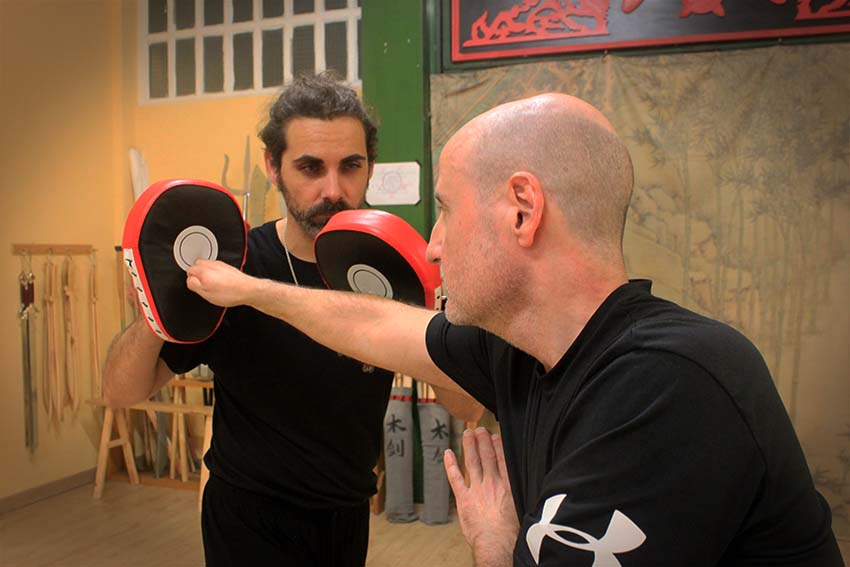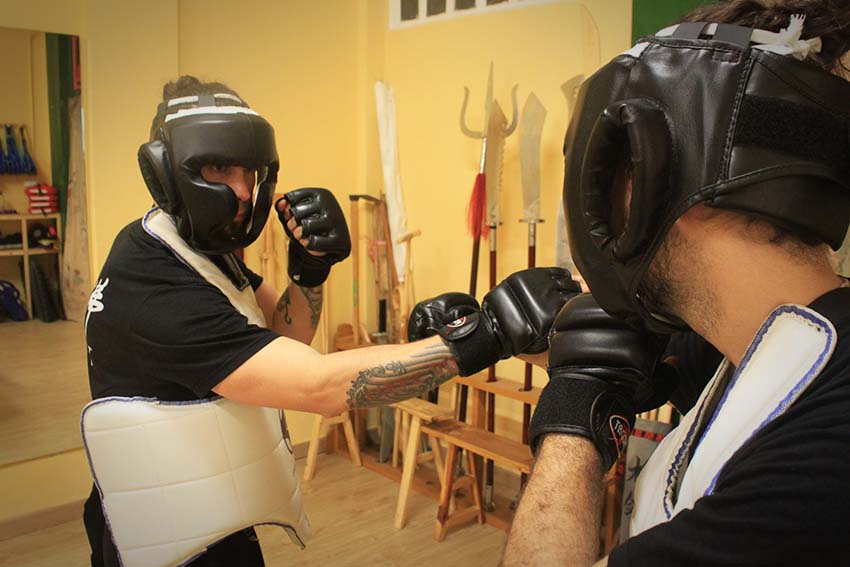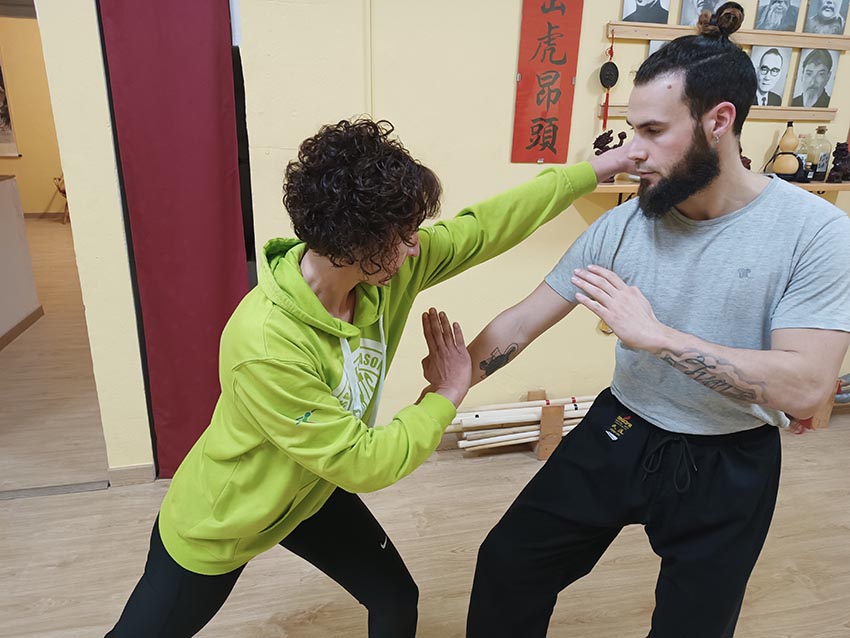Introduction
Every practitioner turns to martial arts for different reasons. Some are looking for an exercise to get in shape, others are looking for a way to release stress, and others are looking for a form of personal development or even a spiritual path – all of which are equally valid reasons. Finally, there are many who turn to a certain martial art for self-defense. But are martial arts useful for this purpose?
In this article we want to explore different dimensions to answer this question.

Are martial arts useful for self-defense?
Well, as you know, we are a martial arts school, so you can guess what our answer is going to be. But not everything is black and white.
Both martial arts, as well as self-defense systems and combat sports, cover a series of skills that are useful when defending against aggression, but they also have a series of limitations that are important to know, either to be able to palliate them or, in any case, to be prepared about them.
Below, we are going to examine a number of relevant points to understand the usefulness of martial arts in the field of self-defense:
1) No training is realistic
No form of training, no martial art, no combat sport or self-defense system, is completely realistic, although it can approach or distance itself from reality to some degree.
The only way to prepare for real violence is to experience it firsthand on a regular basis. Police, guards, criminals, gangsters, have contact with real violence or, at least, with some type of violence, since there are different types and each one can have its particularities. For example, the violence that is exerted in a fight between drunken people in a bar is not the same as the violence that a rapist exerts on a woman alone in a dark alley.
But going into the examination of the different types of violence is beyond the scope of this article. Let's just stick with the fact that only real violence prepares for real violence. And this is for the simple reason that, in a martial arts school, dojo, ring, etc., the opponent in front of us doesn't really want to hurt us. And although their blows may hurt, their intention is not really to threaten our lives.
But there are also other reasons of great relevance. When a person goes to a martial arts school, they expect to be treated well and not to be used as a punching bag. Therefore, any training we do includes deviations from the reality of violence
These deviations can take the form of unrealistic distance, unrealistic timing or speed, unrealistic power, or the use of protections such as gloves, head protectors, etc., which are never present in a real confrontation. All of these deviations are important for our safety.
So when we train barehand sparring with a partner, we can go fast and precise, but without power and, instead, to train power we hit the bag, which does not move on its own. It's an example. Each exercise covers an aspect. Different exercises have to be trained for each of the aspects to be developed (speed, power, distance, timing, precision, etc.). But we never apply them all at the same time in the same exercise, because the risk of injuring ourselves or our partner is very high. But in a real situation, you have to encompass and integrate all these aspects at once, which you never do on the tatami.

2) Specific training should be carried out for this purpose
The practice of a martial art, per se, does not teach self-defense, unless it is trained specifically with this aim. For example, many styles of martial arts devote countless hours to performing forms or katas under the illusion that such training by itself teaches how to fight. How much innocence!
These forms or katas teach the body to move in a coordinated and efficient manner, skills that are indeed very useful, but not enough on their own.
As we have anticipated in the previous point, training must be carried out that covers the maximum possible range of skills that we are going to need and, for this, a methodology and careful planning is needed, which, many times and unfortunately, is absent in certain traditional martial arts schools.
In this regard, if one wants to practice a martial art with a view to acquiring self-defense skills, one should look for an instructor who teaches with a functional approach. Notice that we have said instructor, and not style, since any style is useful when taught correctly, and any style can be absolutely useless when it is not.

3) Each discipline covers a portion of reality
Martial arts is specialized knowledge. Thus, some styles are specialists in striking, others in dislocations and joint control, others in knockdowns, others in ground fighting... These are all areas of reality that we can deal with in a real-world situation. The knowledge gained in them is invaluable, but it must be kept in mind that it is only one portion, and that no style covers the whole.
This is not to say that it is necessary to practice seven or eight different styles, since, in such a case, one can only aspire to acquire a very basic knowledge of each of them. The masters of the past dedicated their lives to often perfecting a single style, even sometimes a single technique! How pretentious it sounds to proclaim oneself a master of five styles.
You don't need to lock yourself into just one style, either. If one really wants to learn how to defend oneself from real aggression, it is often necessary to supplement. For example, most styles of traditional kungfu cover a wide range of skills ranging from punching and kicking to weapon fighting, joint control and takedowns or throws. They are very well-rounded, but they lack ground fighting. Perhaps, a good complement for a practitioner of these styles looking to learn how to defend themselves well, would be a ground fighting style.
It's also possible that we're satisfied with our style and don't want to complement. In this case, it is important to keep in mind the limitations that this entails, so as not to be surprised on the day that (hopefully not) we are forced to defend ourselves or, in any case, to know how to take the match to the terrain in which we are most comfortable.
4) Martial arts can be decontextualized
All styles of traditional martial arts have been used in the past by people who faced violent situations more often than we do now. If these styles have survived to the present day, it is a sign that they work, or at least have worked in the past.
Since the mechanics of the human body, with which every martial art works, are the same now as they were three hundred years ago, we can conclude that what worked in the past must also work now. With a small caveat: although the mechanics of the body are the same, the reality of violence is different in different contexts, both cultural and historical. Which means that a martial art can become outdated.
An obvious example. Many traditional styles include fighting with weapons such as long staff, spear, sabre, and sword. Clearly, these skills were useful in society at the time these styles were developed, but they don't match the reality of violence in our society today, where the chances of defending ourselves with a sword are virtually zero.
This doesn't mean that these skills are not useful. Fighting skills with these weapons can be transferred to the use of a short stick, a cane, an umbrella, a pipe, a bar stool... However, clearly, they are not the most direct way to acquire knowledge adapted to the reality of today's violence.
Therefore, when we turn to a martial art with the intention of learning to defend ourselves, we must make sure that this art includes a solid and consistent system of empty-handed fighting, or can teach us to defend ourselves using everyday objects from our environment.

5) Learning takes time
Generally, a traditional martial art has a fairly slow learning curve. In other words, learning the skills that this discipline aims to transmit requires a long time. Anyone who turns to a martial art with the intention of learning how to defend themselves should keep this in mind.
Some combat sports, such as boxing, cover basic skills in a generally shorter amount of time. That's why – always, usually – an amateur boxer punches better than a lower-middle level martial artist. In return, the martial artist has surely developed a greater range of skills: punching, kicking, takedowns, dislocations, weapon training, etc., although he is not yet able to apply these skills effectively.
There is no objective way to decide which of these two paths is better; the decision depends on each individual's personal preferences. But what is clear is that, when someone starts out in a martial art, it is important to be willing to dedicate time for the acquisition of self-defense skills.

6) Opportunities are found, not sought
One of the best skills that can be developed in martial arts and self-defense is to take advantage of what the opponent is offering us. When we move, no matter how well we are executing our technique, we expose ourselves. There is always some part of our body that is exposed (although obviously the idea is to minimize this exposure), and knowing how to recognize it and exploit it to our advantage is very valuable.
We say this because many people consider certain martial arts techniques to be unrealistic. Perhaps, what is not realistic is the method, for the reasons we have explained above, and we have seen why no training is one hundred percent realistic.
The point is to recognize what the opponent is "offering" to us. Let's take an example: when you are going to apply a dislocation to the elbow and the opponent notices and prevents it, by flexing the elbow, his action opens up other possibilities, such as a dislocation to the shoulder or a knockdown. An average practitioner will get attached to the idea of dislocating the elbow and will enter into a struggle to apply the intended technique, a struggle that is not functional at all. But an advanced practitioner is detached and knows how to recognize the other possibilities, taking the one that appears at the right time. Therefore, all knowledge is valuable and useful if you know how to recognize the right time to apply it.
Conclusion
As we have seen, martial arts (like other combat disciplines) have a number of limitations that need to be understood. This does not mean, at all, that they are not useful. On the contrary, all styles provide invaluable knowledge when it comes to defending oneself from aggression, and in fact have been used successfully by security personnel and state forces, but it is always necessary for training to focus on the application of these skills through appropriate planning.
On the other hand, no technique or style can guarantee that we will come out of an aggression unscathed, but it can certainly increase our chances of overcoming our opponent.
Preferences for a particular style or method depend largely on each person, but, above all, if what we want is to learn how to defend ourselves, it is important to find a teacher or instructor who has a functional approach to the discipline he/she practices.
